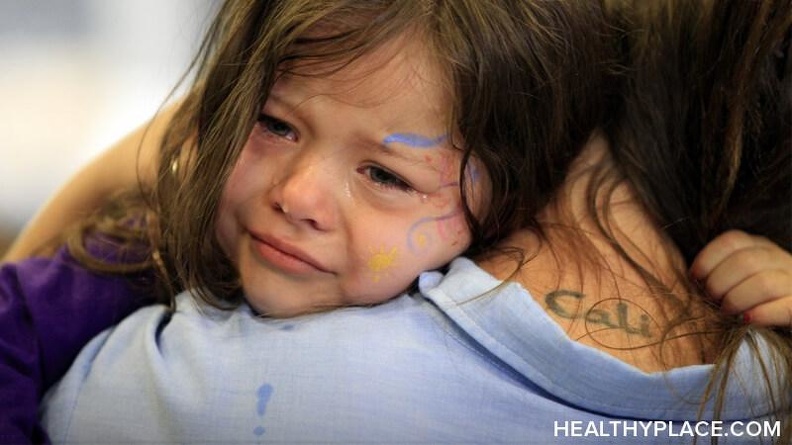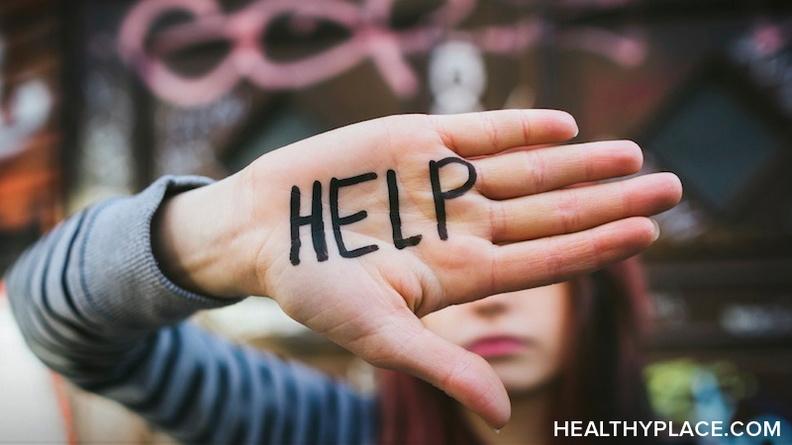
Detailed information on diagnosis and treatment of mental illness in children and adolescents.
How Can I Tell If My Child Needs Help?
It is often difficult to know if a child (under 12) needs help for a psychological problem. Children are so involved with their family that sometimes parents' problems become confused with a child's problems. Divorce, death of a family member, moving, change or loss of parent's job, illness in the family, and going to a new school may all cause stress for children. When deciding whether your child needs help, keep in mind that an appropriate reason to consider treatment for a child is if he or she is generally unhappy.
The following checklist includes some of the signs that could help you decide if your child would benefit from psychological therapy. You may want to find help for your child if any of these warning signs have been present for some time.
What Are Mental Health Warning Signs For Younger Children?
- Displays unusual changes in emotions or behavior.
- Has no friends or has difficulty getting along with other children.
- Is doing poorly in school, misses school frequently, or does not want to attend.
- Has lots of minor illnesses or accidents.
- Is very anxious, worried, sad, scared, fearful, or hopeless.
- Cannot pay attention or sit still; is hyperactive.
- Is disobedient, aggressive, irritable, excessively angry; often screams or yells at people.
- Does not want to be away from you.
- Has frequent disturbing dreams or nightmares.
- Has difficulty falling asleep, wakes up during the night, or insists on sleeping with you.
- Becomes suddenly withdrawn or angry.
- Refuses to eat.
- Is frequently tearful.
- Hurts other children or animals.
- Wets the bed after being toilet-trained.
- Suddenly refuses to be alone with a certain family member, friend, or acts very disturbed when he or she is present.
- Displays affection inappropriately or makes unusual sexual gestures or remarks.
- Talks about suicide or death.
Some of these problems may be resolved by working with a teacher, counselor or school psychologist. Help can also come from concerned family members who offer reassurance, love and the most secure home environment possible.
It is normal for parents to experience guilt feelings because their child is having emotional or behavioral problems. But a child's problems do not always have to do with the home or school environment.
Also, it is possible that problems may be caused by physiological factors, so the child should have a complete medical examination before starting therapy.
How Do I Choose A Mental Health Professional For A Child?
A mental health professional for your child should be warm and caring and still be professional and objective. Parents and children should begin to feel comfortable after several sessions, though both may be anxious, frightened, angry or resistant to treatment at the beginning. Effective mental health professionals are trained to anticipate and work with those emotions so that open communication can be established. To select a mental health professional, you may want to talk to more than one person.
How Does Therapy Work For Children?
When your child is in therapy, the relationship between the mental health professional and the child is the same as it would be with an adult, but you, as the parent, will be involved as an interested third party. Early in therapy, you and the therapist should be able to identify the child's main problems and set goals to solve them.
There are many therapeutic techniques that are used with children. A common technique is play therapy, which gives children a more natural means to communicate with adults. By using games, dolls, and art, the child is often able to express difficult emotions.
Older children with better communication skills may be able to talk more directly with the mental health professional. The counselor or therapist may suggest other family members come for a number of sessions to help understand how the family works as a system. He/she may suggest new ways to relate to your child at home.
It may take time for your child to get comfortable in therapy. Just as with adults and adolescents, problems may become worse before they get better. Try to get your child to stick with therapy until he/she feels comfortable. However, if the child really seems to distrust the therapist after some time, it is a good idea to look for someone else.
How Is Therapy For Children Evaluated?
It is as important in child therapy as it is in adult therapy for the parent periodically to evaluate the progress of the treatment and the relationship with the therapist. After your child has been in therapy for a while, ask yourself the following questions to determine if therapy is working. If the answer to most of them is "yes," then you should be confident that therapy is helping. If the answer to most of them is "no," then you may want to get a second opinion from another therapist and consider making a change in your child's treatment.
- Does our child seem comfortable with the therapist?
- Is there open communication between the therapist and us, the parents?
- Has the therapist diagnosed the problem our child is having?
- Has the therapist identified our children's strengths?
- Are the therapist and our child working toward the goals we set together?
- Has our relationship with our child improved?
- Are we, the parents, being given guidance to work on our child's problem and increase his/her strengths?
How Do I Know When My Child Can Stop Therapy?
Your child may be ready to stop therapy when he/she:
- Is much happier.
- Is doing better at home and in school.
- Is making friends.
- You understand and have learned how to deal more effectively with those factors that led to the problems for which you sought help.
Sometimes, ending therapy will be an anxious time for children and parents. Problems may reappear temporarily. The mental health professional should be available to provide counsel and support for a period of time after your child is finished with therapy. It is a good idea to allow some time to adjust before considering going back into therapy.
You and your child may benefit from support groups.
Finding Help for Adolescents
Disturbed behavior in adolescents may be related to the physical and psychological changes taking place. This is a time when young people are often troubled by sexual identity and very concerned with physical appearance, social status, parents' expectations, and acceptance from peers. Young adults are establishing a sense of self-identity and shifting from parental dependence to independence.
A parent or concerned friend may have difficulty deciding what "normal behavior" is and what may be signs of emotional or mental health problems. The checklist below should help you decide if an adolescent needs help. If more than one sign is present or lasts a long time that may indicate a more serious problem.
What Are Mental Health Warning Signs For Older Children & Adolescents?
- Unexplained decline in schoolwork and excessive absences.
- Neglect of appearance.
- Marked changes in sleeping and/or eating habits.
- Running away.
- Frequent outbursts of anger.
- Defiance of authority, truancy, theft and/or vandalism.
- Excessive complaints of physical ailments.
- Drug or alcohol use or abuse.
Seek immediate help when an adolescent:
- Hears or sees things that are not there.
- Is preoccupied with themes of death.
- Gives away prized possessions.
- Threatens suicide.
Parents and friends can help a young person who may be experiencing these problems. Be a good listener. Let her/him know why you are concerned.
In more serious cases or a crisis, it is important to get immediate assistance or crisis intervention (call your usual health care provider or your local crisis center).
Teachers, school counselors, physicians, or peer-support groups may be helpful. Mental health professionals are also available to help evaluate an adolescent's problems.
If a decision is made to seek professional help, it is very important that the adolescent be aware of choices and be involved in making a plan.
How Do I Choose A Mental Health Professional For An Adolescent?
The mental health professional you choose for your adolescent should have expertise in dealing with the unique problems of adolescence. You should feel comfortable with the therapist and feel that you can establish open communication and that you can get your questions answered. However, your adolescent may not feel comfortable with the therapist or may be hostile to him/her.
How Does Therapy Work With An Adolescent?
When adolescents are involved in therapy, they can and should speak for themselves. Parents may or may not be included in the therapy sessions, or may be encouraged to participate in family therapy or group sessions. Therapy with a peer group is helpful for many teens.
The adolescent and the therapist should discuss what each expects to accomplish. In addition to mental health therapy sessions, treatment for substance abuse may be necessary in order to address mental health problems. The entire family may be asked to participate in a number of sessions to help understand how the family communicates, works together, and how they can assist with the adolescent's problems.
It is important for parents to understand that there may be certain aspects of the therapy that should remain confidential between the mental health professional and the adolescent. Before treatment begins, the parents, the adolescent, and the therapist should come to an agreement as to what information will be disclosed to the parents.
How Is Therapy Evaluated for An Adolescent?
It is just as important in adolescent therapy as it is in adult therapy to periodically evaluate the progress of the treatment and the relationship with the therapist. Once your adolescent has been in therapy for a while, ask yourself the following questions to see if you believe therapy is working.
If you answer "yes" to most of them, then you can be confident that therapy is helping. If you answer "no" to most of them, then you may want to get a second opinion from another therapist and consider making a change in your adolescent's treatment.
- Is our adolescent more positive about therapy?
- Has the therapist diagnosed the problem and are the two of them working toward treatment goals that include our adolescent's strengths?
- Is our adolescent becoming free from any use or addictions to drugs and/or alcohol?
- Has our relationship with our adolescent improved?
- Is there communication between the therapist and us, the parents?
How Can I Tell When My Adolescent Can Stop Therapy?
Your adolescent and the mental health professional will probably decide they are ready to stop therapy when the adolescent:
- Is generally happier, more expressive and cooperative, and less withdrawn.
- Is functioning better at home and in school.
- Is free from use or addictions to drugs and/or alcohol.
Ending therapy may be an anxious time for adolescents and parents. Problems may reappear temporarily. The therapist should be available to provide counsel and support for a period of time after your adolescent finishes therapy. Give yourselves some time to adjust before considering going back into therapy. You and your adolescent may benefit from participation in support groups.
Services For Children And Adolescents
Parents of children and adolescents with emotional disturbances need to know what the full range of services for their children should be. Here is a set of ideal options ranging from home-based services to the most restrictive hospital setting. Ask your child's doctor, school counselor or your local Family Guidance Center for help finding and arranging for the services described below.
Home intervention
The purpose of the home-based model of treatment is to provide intensive in-home crisis intervention to keep children from being placed outside their homes, away from their families. Such programs are directed toward managing crises and teaching families new ways of resolving problems to prevent future crises.
Successful home intervention programs have therapists available to families 24 hours a day for 4 to 6 weeks. During this period, families receive regular training sessions in their homes and may call on the therapists for help any time a crisis arises. The therapist can provide behavior interventions, client-centered therapy, values clarification, problem-solving, crisis intervention, and assertiveness training. They also help with home management and budgeting skills, advocacy, and referral for legal, medical, or social services.
Intensive home-based treatment helps make a more accurate assessment of the child and of the family's functioning. This treatment also makes it easier for the therapist to show and develop new behaviors in the child's normal environment. Therapists can directly observe the treatment plan and revise it when needed.
School-based services
Schools must provide appropriate special education and related services for children who are identified as seriously emotionally disturbed and in need of special educational help. For qualifying children, school staff and parents write an Individualized Education Program (IEP), which specifies the amount and type of special education the child requires, the related services the child may need, and the type of placement which is suitable for teaching the child.
Special education services are specifically educational in nature. While these educational services may be helpful to the emotionally disturbed child, a more complete treatment program may also be needed, such as psychotherapy services.
Special education services must be provided at no cost to parents. The IEP must be revised at least every year, with parents participating in the revision.
How can my child get help through their school?
If your child has emotional or behavioral problems that upset their school attendance or performance, talk to the teacher, counselor, and/or principal of your child's school (public or private) and ask for an evaluation of your child.
If you think your child would benefit from special education and mental health services, ask your local public school for a "Request for Evaluation" Form and related information leaflets and brochures. Private school students can be evaluated by the public school they would have attended.
If mental health and other support services are needed for your child, a case manager should be assigned to help you and your child find and use all the services that may be needed (e.g., education, mental health, vocational). A school counselor can assist.
Community-based outpatient treatment
Outpatient treatment usually means that the child lives at home and receives psychotherapy at a local mental health clinic or from a private therapist. Sometimes psychotherapy is combined with a home intervention and/or a school-based special education program. Outpatient therapy may involve individual, family, or group therapy, or a combination of them.
For families who do not have private insurance coverage, but may have QUEST or Medicaid or no insurance, there are state-funded Family Guidance Centers within each Community Mental Health Center to assist families in receiving the appropriate outpatient treatment or other referral for children and adolescents. Community-based day treatment (also called Community-based instruction) Day treatment is the most intensive nonresidential type of treatment. It has the advantages of keeping the child in the home, while bringing together a broad range of services designed to strengthen the child and improve family functioning. The specific features of day treatment programs vary from one program to another, but may include some or all of the following components:
- Special education, generally in small classes with a strong emphasis on individualized instruction.
- Psychotherapy, which may include both individual and group sessions.
- Family services, which may include family psychotherapy, parent training, brief individual therapy with parents, help with specific tangible needs such as transportation, housing, or medical attention.
- Vocational training.
- Crisis intervention.
- Skill building with an emphasis on interpersonal and problem-solving skills and practical skills of everyday living.
- Behavior modification.
- Recreation therapy, art therapy, and music therapy to aid social and emotional development.
- Drug and/or alcohol counseling.
- Children participate in a day treatment program for 6 hours a day. Lengths of stay are usually one school year, but can be shorter or longer.
Some day treatment programs are physically located on a school site where they may have a wing of their own that includes classrooms and office space. Other day programs are run in mental health centers, other community agencies, or on the grounds of a private clinic or hospital.
Community-based residential programs
Community-based residential programs involve the use of either group homes or therapeutic foster homes. This type of treatment assumes that there is a need to bring about a total change in the child's environment.
Foster-home placement
Foster home placement is, in many ways, a "natural" approach to treatment because it provides a family unit, which is the normal developmental situation for a child. A foster home will provide additional components beyond the nurturing characteristics of a wellorganized family. These additional components may include special training for the foster parents in behavior modification and crisis intervention.
"Therapeutic" foster homes offer additional support, including psychotherapy and case management. Therapeutic foster homes usually foster only one child at a time, whereas regular foster homes may have multiple children placed with them.
Group-home placement
Group home placement is somewhat more restrictive than foster care, since the living situation is not as "natural." Group homes provide family-style treatment in a more structured setting than the natural environment. Treatment usually involves a combination of evaluation, psychotherapy, use of behavior modification, peer interaction, and increasing self-government.
Residential treatment centers
Residential treatment centers provide round-the-clock treatment and care for children with emotional disturbances who need continuous medication, supervision, or relief from stresses in the environment, or whose families require relief from the stress of caring for them. Residential treatment centers for severely emotionally disturbed children are available throughout the United States.
Many of these facilities focus on a particular treatment philosophy. Generally, residential centers base their treatment on the premise that the child's total environment must be structured in a therapeutic way. Some emphasize special diet and exercise programs; others concentrate on behavior modification programs which function both in the classrooms and in the dormitories as well. Still others use a patient-centered, "structured permissiveness" approach. Some treatment centers are set up to deal specifically with alcohol and drug-related problems.
While residential treatment centers have academic programs, a great deal of attention is focused on the child's emotional problems, regardless of whether these problems are associated with academic matters. Considerable time and effort are spent on group and individual therapy and therapeutic social activities.
Residential care/hospital or training school Residential care in a hospital or training school tends to be the most restrictive type of treatment, attempted after other, less intensive, forms of treatment have been tried and have failed, or when a child has violated the law and has been ordered by the court to a particular facility.
- A psychiatric hospital is a medical facility whose emphasis is on medical solutions to mental problems. Psychiatric hospitals tend to use medications, and sometimes other physiological interventions. Those hospitals which serve children must provide educational opportunities for them, but the main focus of these facilities is not academics.
- Training schools are generally a type of correctional facility that is intended to serve delinquent youth. Depending on the level of financial support and degree of commitment from state government, some training schools offer psychotherapy, behavior modification programs, and/or vocational training. In general, training schools are not desirable treatment facilities because they are usually under-funded and often operate as prison-like programs. All training schools are required by federal law to provide appropriate special education for children who qualify.
- Respite Services give families (natural, adoptive or extended) temporary relief from caring for a child or teen who is receiving mental health services through a family guidance center or a private mental health provider. Contact your local Family Guidance Center for more information.
What Medications Can Help Children And Adolescents' Mental Health Problems?
Medication can be an effective part of the treatment for several psychiatric disorders of childhood and adolescence. A doctor's recommendation to use medication often raises many concerns and questions in both the parents and the youngster. The physician who recommends medication should be experienced in treating psychiatric illnesses in children and adolescents. He or she should fully explain the reasons for medication use, what benefits the medication should provide, as well as side effects or dangers and other treatment alternatives.
Psychiatric medication should not be used alone. As undertaking a medication trial may mean adjusting doses of medicine over time and/or the use of additional medications to meet an individual youngster's needs, the use of medication should be part of a comprehensive treatment plan, usually including psychotherapy as well as parent guidance sessions.
Before recommending any medication, the child and adolescent psychiatrist will interview the youngster and make a thorough diagnostic evaluation. In some cases, the evaluation may include a physical exam, psychological testing, laboratory tests, other medical tests such as an electrocardiogram (EKG) or electroencephalogram (EEG), and consultation with other medical specialists.
Child and adolescent psychiatrists stress that medications which have beneficial effects also have unwanted side effects, ranging from annoying to very serious. As each youngster is different and may have individual reactions to medication, close contact with the treating physician is recommended. Psychiatric medication should be used as part of a comprehensive plan of treatment, with ongoing medical assessment and, in most cases, individual and/or family psychotherapy.
When prescribed appropriately by a psychiatrist (preferably a child and adolescent psychiatrist), and taken as prescribed, medication may reduce or eliminate troubling symptoms and improve the daily functioning of children and adolescents with psychiatric disorders.
Do not stop or change a medication without speaking to the doctor.
Illnesses That Are Prescribed Medication
- Bedwetting -- if it persists regularly after age five and causes serious problems in self-esteem and social interaction.
- Anxiety (school refusal, phobias, separation or social fears, generalized anxiety, or posttraumatic stress disorders) --if it keeps the youngster from normal daily activities.
- Attention deficit hyperactivity disorder (ADHD), marked by a short attention span, trouble concentrating and restlessness.
- The child is easily upset and frustrated, often has problems getting along with family and friends, and usually has trouble in school.
- Obsessive-compulsive disorder -- recurring obsessions (troublesome and intrusive thoughts) and/or compulsions (repetitive behaviors or rituals such as hand washing, counting, and checking to see if doors are locked) which are often seen as senseless and which interfere with a youngster's daily functioning.
- Depressive disorder -- lasting feelings of sadness, helplessness, hopelessness, unworthiness, guilt, inability to feel pleasure, a decline in schoolwork and changes in sleeping and eating habits.
- Eating disorder -- either self-starvation (anorexia nervosa) or binge eating and vomiting (bulimia), or a combination of the two.
- Bipolar disorder -- periods of depression alternating with manic periods, which may include irritability, "high" or happy mood, excessive energy, behavior problems, staying up late at night, and grand plans.
- Psychosis -- symptoms include irrational beliefs, paranoia, hallucinations (seeing things or hearing sounds that do not exist), social withdrawal, clinging, strange behavior, extreme stubbornness, persistent rituals, and deterioration of personal habits. May be seen in developmental disorders, severe depression, schizoaffective disorder, schizophrenia, and some forms of substance abuse.
- Autism (or other pervasive developmental disorder such as Asperger's Syndrome) -- characterized by severe deficits in social interactions, language, and/or thinking or ability to learn, and usually diagnosed in early childhood.
- Severe aggression -- which may include assaultiveness, excessive property damage, or prolonged self-abuse, such as head banging or cutting.
- Sleep problems -- symptoms can include insomnia, night terrors, sleepwalking, fear of separation, and anxiety.
Types Of Psychiatric Medications
- Stimulant Medications: Stimulant medications are often useful as part of the treatment for attention deficit hyperactive disorder (ADHD). Examples include Dextroamphetamine (Dexedrine, Adderal), Methylphenidate (Ritalin), and Pemoline (Cylert).
- Antidepressant Medications: Antidepressant medications are used in the treatment of depression, school phobias, panic attacks, and other anxiety disorders, bedwetting, eating disorders, obsessive-compulsive disorder, personality disorders, posttraumatic stress disorder, and attention deficit hyperactive disorder. There are several types of antidepressant medications:
- Tricyclic antidepressants (TCA's), which include: Amitriptyline (Elavil), Clomipramine (Anafranil), Imipramine (Tofranil), and Nortriptyline (Pamelor). Serotonin reuptake inhibitors (SRI's), which include: Fluoxetine (Prozac), Sertraline (Zoloft), Paroxetine (Paxil), Fluvoxamine (Luvox), Venlafaxine (Effexor), and Citalopram (Celexa).
- Monoamine oxidase inhibitors (MAOI's), which include: Phenelzine (Nardil), and Tranylcypromine (Parnate).
- Atypical antidepressants, which include: Bupropion (Wellbutrin), Nefazodone (Serzone), Trazodone (Desyrel), and Mirtazapine (Remeron).
Antipsychotic Medications
Antipsychotic medications can be helpful in controlling psychotic symptoms (delusions, hallucinations) or disorganized thinking. These medications may also help the muscle twitches ("tics") or verbal outbursts seen in Tourette's Syndrome. They are occasionally used to treat severe anxiety and may help in reducing very aggressive behavior.
Examples of traditional antipsychotic medications include: Chlorpromazine (Thorazine), Thioridazine (Mellaril), Fluphenazine (Prolixin), Trifluoperazine (Stelazine), Thiothixene (Navane), and Haloperidol (Haldol).
Newer antipsychotic medications (also known as atypical or novel) include: Clozapine (Clozaril), Risperidone (Risperdal), Quetiapine (Seroquel), Olanzapine (Zyprexa), and Ziprasidone (Zeldox).
Mood Stabilizers and Anticonvulsant Medications
Mood stabilizers may be helpful in treating manic depressive episodes, excessive mood swings, aggressive behavior, impulse control disorders and severe mood symptoms in schizoaffective disorder and schizophrenia.
- Lithium (lithium carbonate, Eskalith) is an example of a mood stabilizer.
- Some anticonvulsant medications can also help control severe mood changes, such as Valproic Acid (Depakote, Depakene), Carbamazepine (Tegretol), Gabapentin (Neurontin), and Lamotrigine (Lamictil).
Anti-anxiety Medications
Anti-anxiety medications may be helpful in the treatment of severe anxiety. There are several types of anti-anxiety medications:
- Benzodiazepines, such as Alprazolam (Xanax), lorazepam (Ativan), Diazepam (Valium), and Clonazepam (Klonopin).
- Antihistamines, which include: Diphenhydramine (Benadryl), and Hydroxizine (Vistaril).
- Atypical anti-anxiety medications, which include: Buspirone (BuSpar), and Zolpidem (Ambien).
When prescribed appropriately by an experienced psychiatrist (preferably a child and adolescent psychiatrist) and taken as directed, medication may reduce or eliminate troubling symptoms and improve daily functioning of children and adolescents with psychiatric disorders.
Sleep Medications
A variety of medications may be used for a short period to help with sleep problems.
Examples include: SRI anti-depressants, Trazodone (Desyrel), Zolpidem (Ambien), and Diphenhydramine (Benadryl).
Miscellaneous Medications
Other medications are also being used to treat a variety of symptoms. For example, clonidine (Catapres) may be used to treat the severe impulsiveness in some children with ADHD and guanfacine (Tenex) for "flashbacks" in children with PTSD.
Sources:
- California Dept. of Mental Health
- Mental Health Association in Hawaii









